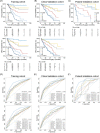Development and validation of a prognostic model incorporating tumor thrombus grading for nonmetastatic clear cell renal cell carcinoma with tumor thrombus: A multicohort study
- PMID: 37484972
- PMCID: PMC10357251
- DOI: 10.1002/mco2.300
Development and validation of a prognostic model incorporating tumor thrombus grading for nonmetastatic clear cell renal cell carcinoma with tumor thrombus: A multicohort study
Abstract
There is significant variability with respect to the prognosis of nonmetastatic clear cell renal cell carcinoma (ccRCC) patients with venous tumor thrombus (VTT). By applying multiregion whole-exome sequencing on normal-tumor-thrombus-metastasis quadruples from 33 ccRCC patients, we showed that metastases were mainly seeded by VTT (81.8%) rather than primary tumors (PTs). A total of 706 nonmetastatic ccRCC patients with VTT from three independent cohorts were included in this study. C-index analysis revealed that pathological grading of VTT outperformed other indicators in risk assessment (OS: 0.663 versus 0.501-0.610, 0.667 versus 0.544-0.651, and 0.719 versus 0.511-0.700 for Training, China-Validation, and Poland-Validation cohorts, respectively). We constructed a risk predicting model, TT-GPS score, based on four independent variables: VTT height, VTT grading, perinephric fat invasion, and sarcomatoid differentiation in PT. The TT-GPS score displayed better discriminatory ability (OS, c-index: 0.706-0.840, AUC: 0.788-0.874; DFS, c-index: 0.691-0.717, AUC: 0.771-0.789) than previously reported models in risk assessment. In conclusion, we identified for the first-time pathological grading of VTT as an unheeded prognostic factor. By incorporating VTT grading, the TT-GPS score is a promising prognostic tool in predicting the survival of nonmetastatic ccRCC patients with VTT.
Keywords: clear cell renal cell carcinoma; pathological grading; prognostic model; risk stratification; venous tumor thrombus.
© 2023 The Authors. MedComm published by Sichuan International Medical Exchange & Promotion Association (SCIMEA) and John Wiley & Sons Australia, Ltd.
Conflict of interest statement
All authors declare no competing interests.
Figures





References
-
- Blute ML, Leibovich BC, Lohse CM, Cheville JC, Zincke H. The Mayo Clinic experience with surgical management, complications and outcome for patients with renal cell carcinoma and venous tumour thrombus. BJU Int. 2004;94(1):33‐41. - PubMed
-
- Ljungberg B, Albiges L, Abu‐Ghanem Y, et al. European association of urology guidelines on renal cell carcinoma: the 2022 Update. Eur Urol. 2022. - PubMed
-
- Karakiewicz PI, Briganti A, Chun FK‐H, et al. Multi‐institutional validation of a new renal cancer–specific survival nomogram. J Clin Oncol. 2007;25(11):1316‐1322. - PubMed
LinkOut - more resources
Full Text Sources
